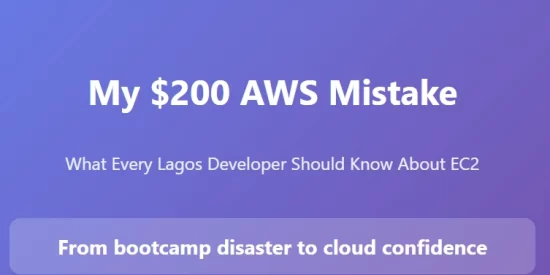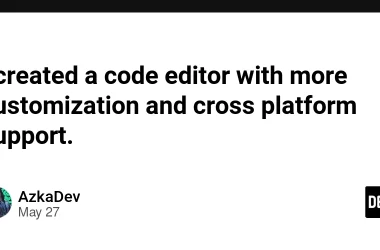“Free tier” they said. “12 months free” they said. Nobody told me about the small print that would cost me my peace of mind, $200 of real money, and nearly derail my cloud learning journey.
You know how it is when you’re just minding your own business, juggling activities from Monday to another Monday, trying to make ends meet as a student in Lagos? That was me – coding small projects, watching YouTube tutorials, and basically living my quiet developer life.
Then boom! I stumbled across this ad for a “FREE Cloud Computing Bootcamp” on social media. You know how these ads find you when you’re not even looking? The way they described it made it sound like the opportunity of a lifetime:
“Learn Cloud Computing in 6 Weeks!”
“AWS Free Tier – Practice for 12 Months at No Cost!”
“From Zero to Cloud Engineer!”
Me, being the small girl that I am (you know how we Nigerians say “small girl” even when we’re grown 😂), I was like “Ah! This is my chance!” I registered faster than you could say “Amazon Web Services.”
What I didn’t know was that this “free” opportunity was about to teach me the most expensive lesson of my tech career. A lesson that would eventually transform me into one of Nigeria’s most cost-conscious cloud engineers, helping organizations across Lagos save thousands of dollars on their cloud infrastructure.
The first week was pure theory – beautiful slides about cloud computing, diagrams of AWS architecture, and explanations of services that sounded like magic. I was taking notes like my life depended on it, feeling very intelligent and ready to conquer the cloud.
The instructor kept emphasizing: “Don’t worry about costs, you’re on the Free Tier! You have 12 whole months to practice!”
As a small girl who had been managing with ₦500 airtime per week, this sounded too good to be true. But hey, who was I to question free stuff?
Red Flag #1: Nobody explained what “Free Tier limits” actually meant. This should have been Day 1, Hour 1 content. Today, this is exactly where I start with every client consultation because I’ve learned that prevention is infinitely cheaper than cure.
Then came week 2 – hands-on time! The instructor said:
“Alright everyone, create your AWS account and let’s spin up some resources!”
Now, as the eager small girl I was, I didn’t just follow the basic instructions. I was thinking:
“If it’s free for 12 months, let me explore everything! Let me create multiple instances, try different services, maybe set up a whole production environment for practice!”
The instructor showed us how to launch one t2.micro EC2 instance. Me? I launched three – “just to see how they work together,” I told myself. Then I created an RDS database because “I might need it later.” Then some S3 buckets for “future projects.” Oh, and a load balancer because “why not learn everything at once?”
The AWS console was like a new toy, and I was that child who opens all the features at once.
Red Flag #2: The bootcamp instructor never mentioned setting up billing alerts or cost monitoring before launching resources. This is like teaching someone to drive without mentioning brakes. Now, I make sure every single client has comprehensive billing alerts set up before we deploy anything to production.
What could possibly go wrong, right?
Here’s where the story gets interesting (and by interesting, I mean catastrophically expensive).
Two weeks into my AWS learning journey, my laptop decided to give up on life. You know how it is in Lagos – one day your laptop is fine, the next day it’s making sounds like a generator that hasn’t been serviced in years. Off to Computer Village it went, and I was told it would take “at least a week” to fix.
“No wahala,” I thought. “I’ll just focus on theory for now.”
What I didn’t realize was that my AWS resources were still running. Those EC2 instances I’d spun up for practice? Still chugging along, burning through compute hours like there was no tomorrow. That RDS database I’d created to test some queries? Happily consuming storage and compute cycles 24/7. The load balancer? Routing traffic to nowhere but still billing me hourly.
The Crucial Mistake: I thought AWS resources were like downloaded software – once you start them, they just exist until you actively delete them. I had no idea they were charging by the hour, even when idle. This fundamental misunderstanding is what I now call “the ₦80,000 lesson that made me Nigeria’s most paranoid cloud cost optimizer.”
When I finally got my laptop back after 10 days (Lagos repair time, you understand), I eagerly logged into AWS to continue my learning. Instead of the warm welcome I expected, I was greeted by an email that made my heart skip several beats:
“Your AWS bill for this month: $200.47”
Two hundred dollars! As a student in Nigeria, that might as well have been two million naira. At the exchange rate then, this was about ₦82,000 – more than some people’s monthly salary. I stared at that number like it was written in ancient Greek, hoping my eyes were deceiving me.
But wait – there’s more drama. Because I had no way to pay this amount (student budget, remember?), AWS had suspended my account. All my learning progress, my carefully crafted infrastructure, my beautiful EC2 instances – all locked away behind a paywall I couldn’t afford.
I felt like I’d been scammed, but the only person I could blame was the guy in the mirror.
After the initial shock wore off (and maybe a few choice Yoruba words), I decided to fight back. I reached out to AWS Support, crafting what I thought was a compelling case:
- I was a student learning cloud computing
- My laptop broke and I couldn’t monitor my resources
- I provided proof of enrollment at my university
- I explained the circumstances honestly and professionally
- I even wrote about my financial situation as a Nigerian student
I waited anxiously for their response, hoping for some compassion, maybe a partial waiver, anything to reduce this crushing debt.
Their response was polite but firm: No waiver. Full payment required.
The customer service rep explained that while they understand my situation, the resources did consume actual computing power, and AWS policy doesn’t allow for billing adjustments based on user error or circumstances, regardless of student status.
The Hard Truth: Unlike mobile networks that might show mercy when you accidentally subscribe to premium services, AWS operates on strict “you use it, you pay for it” principles. There’s no “student forgiveness” policy.
That day I learned that in the cloud world, ignorance is expensive, and there’s no mercy for honest mistakes. It was also the day I decided to become the most cost-conscious cloud engineer in Nigeria.
With no choice but to pay, I had to get creative:
- Family Emergency Fund: I had to explain to my parents why I needed ₦82,000 for “computer education”
- Freelance Hustle: I took on every small coding gig I could find for the next two months
- Payment Plan: I negotiated a payment plan with AWS to spread the cost over 3 months
- Lifestyle Adjustment: No eating out, no new clothes, back to basic Nokia phone for a while
The Silver Lining: This financial pain made me never forget the lesson. Pain is a powerful teacher. More importantly, it forced me to become obsessive about cloud cost optimization – a skill that now saves my clients tens of thousands of dollars annually.
After some serious introspection and research, I realized my mistake wasn’t using AWS – it was using it blindly. Here’s what I learned the hard way, lessons that now form the foundation of my cloud consulting practice:
The AWS Free Tier is like those “free” data plans Nigerian telecos offer. There are specific limits, and when you cross them, the charges start flowing like rainwater in Lagos during rainy season.
Critical Free Tier Limits Everyone Should Memorize:
- EC2: 750 hours per month (one t2.micro instance running 24/7, NOT multiple instances)
- RDS: 750 hours per month of db.t2.micro usage
- S3: 5GB of standard storage, 20,000 GET requests, 2,000 PUT requests
- Data Transfer: 1GB per month
- Load Balancers: NOT included in free tier (this was my biggest mistake)
Key Insight: The free tier is designed for one small application, not for experimenting with multiple services simultaneously. This understanding now helps me design cost-effective architectures for startups and SMEs across Nigeria.
You know how your bank sends you SMS alerts when your account balance drops? AWS can do the same thing, but you have to set it up BEFORE you touch anything else. This is now the very first thing I implement for every single client, no exceptions.
Think of AWS resources like hiring workers: every instance you launch is like hiring someone to work for you 24/7 until you explicitly fire them (terminate the instance). Even if they’re doing nothing, they’re still on your payroll. This analogy has helped dozens of Nigerian business owners understand cloud costs better than any technical explanation ever could.
Some services that seem “small” can generate big bills:
Load Balancers: $18/month minimum (NOT free tier eligible)
NAT Gateways: $45/month each
RDS Multi-AZ: Double the cost
Data Transfer: Can be expensive between regions
Elastic IPs: Charged when not attached to running instances
After paying my expensive tuition to the “University of AWS Hard Knocks,” I rebuilt my learning environment with proper safeguards. More importantly, I developed a comprehensive cost control methodology that I now use to help Nigerian businesses optimize their cloud spending.
I created what I call my bulletproof cost protection system – the same system I now implement for clients across Lagos, Abuja, and Port Harcourt:
As Nigerians, we’re used to prepaid everything:
- Prepaid electricity
- Prepaid phone credit
- Pay-as-you-go internet
- Upfront school fees
Cloud computing flips this completely. It’s like having a meter running on everything you touch, and the bill comes later. Understanding this psychological shift is crucial for Nigerian businesses moving to the cloud.
Mental Model Shift Required:
- Think “rental” not “purchase”
- Every click has a cost
- Idle resources still cost money
- Deletion is the only way to stop charges
This mindset shift is something I now help every client internalize during our onboarding process.
That expensive mistake turned into career gold and the foundation of my cloud consulting practice:
When interviewing for cloud roles, I tell this story. It shows:
- Real hands-on experience (expensive proof!)
- Learning from mistakes
- Cost consciousness (invaluable in business)
- Problem-solving skills
More importantly, it gives me credibility as a DevOps engineer, technical writer, and cloud security/SRE specialist when helping organizations avoid similar costly mistakes.
I now help startups and established companies globally set up cost-effective, secure cloud environments. My $200 mistake credentials are perfect for this – nobody questions my expertise in cloud cost optimization and security after hearing this story.
I’ve helped organizations worldwide avoid similar mistakes through:
- Comprehensive cloud cost audits
- Custom monitoring and alert systems
- Cost optimization consulting
- Team training on cloud financial management
- Architecture reviews focused on cost efficiency
The cost monitoring systems I built after my mistake taught me:
- CloudFormation/Terraform for infrastructure as code
- Lambda functions for automation
- Advanced cost optimization techniques
- DevOps practices and cloud architecture
- The critical balance between technical capabilities and business impact
Always calculate costs in Naira:
- $1 = ₦400+ (depending on current rates)
- That innocent $5/month service = ₦2000+/month
- Budget in Naira, think in Naira
This Naira-first approach to cloud budgeting is something I emphasize with clients, adapting the currency calculations based on their local context and exchange rates.
Join Nigerian Tech Communities:
- AWS User Group Nigeria (LinkedIn/WhatsApp)
- Nigeria DevOps Community
- Local tech meetups in Lagos, Abuja, Port Harcourt
- University AWS clubs
I’m active in tech communities globally, sharing cost optimization strategies and helping engineers avoid expensive cloud mistakes through technical writing and consulting.
After this experience, I believe every cloud bootcamp in Nigeria should include comprehensive cost management training from day one. This is why I now offer specialized workshops for educational institutions and training organizations.
If you find yourself in a similar position, here’s my battle-tested recovery strategy:
Immediate Actions (First 24 Hours):
- Stop the bleeding: Immediately terminate/stop all resources
- Document everything: Screenshot bills, resource lists, circumstances
- Contact AWS Support: Be honest, professional, provide context
- Check for unused resources: Elastic IPs, volumes, snapshots
Medium-term Strategy (Next 30 Days):
- Payment negotiation: Ask for payment plans
- Skill monetization: Use the crisis to fast-track learning
- Community help: Reach out to local tech communities
Long-term Prevention:
- Build monitoring systems: Implement comprehensive cost controls
- Create learning protocols: Standardized safe practices
- Career leverage: Turn the experience into professional advantage
That $200.47 AWS bill – every kobo of it paid from my student budget with no mercy from AWS – turned out to be the most valuable education I ever received. Not because I wanted to pay it, but because I chose to learn everything possible from it.
Here’s what that expensive week taught me:
Technical Skills:
- Advanced AWS cost management and optimization
- Infrastructure monitoring and automation
- DevOps practices and cloud architecture
- Real-world problem-solving under financial pressure
Business Acumen:
- Understanding the financial impact of every technical decision
- Cost optimization strategies that save companies thousands
- Budget planning and management for cloud infrastructure
- Risk assessment and mitigation in cloud environments
Career Advantages:
- Unique expertise in cloud cost optimization
- Proven experience with financial discipline in cloud environments
- Consulting opportunities with cost-conscious Nigerian businesses
- Training and mentoring credentials backed by real experience
Today, I help manage cloud environments for companies globally as a DevOps engineer and SRE, and I’ve never had another surprise bill. More importantly, I’ve helped businesses across multiple continents optimize their cloud spending, often reducing their AWS bills by 30-60% without compromising performance or reliability.
The organizations I work with now save more in a single month than I spent on that painful lesson. But that lesson gave me the paranoid cost-consciousness that makes me invaluable to any business moving to the cloud – whether they’re in Lagos, London, or Silicon Valley.
If you’re reading this and about to start your cloud journey, remember: The cloud is incredibly powerful, but every click has a cost. Set up your financial guardrails before you touch anything else.
And if you’re a business considering cloud migration, don’t make the same expensive mistakes I did. The cloud offers incredible opportunities for growth and efficiency, but only if you understand the financial implications from day one.
Your future self (and your bank account) will thank you for being paranoid about costs from Day 1.
Ready to optimize your cloud costs or avoid expensive mistakes? I’ve turned my costly AWS lesson into expertise that saves businesses thousands globally. As a DevOps engineer, technical writer, and cloud security/SRE specialist, let’s talk about how proper cloud financial management can accelerate your growth without breaking your budget.

![[boost]](https://prodsens.live/wp-content/uploads/2025/07/37021-boost-110x110.png)



